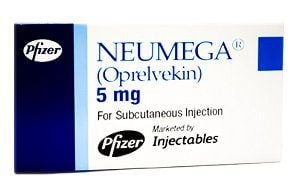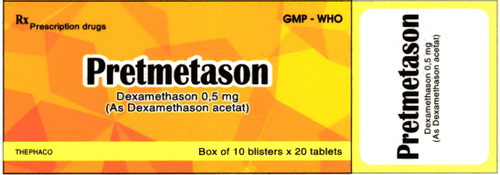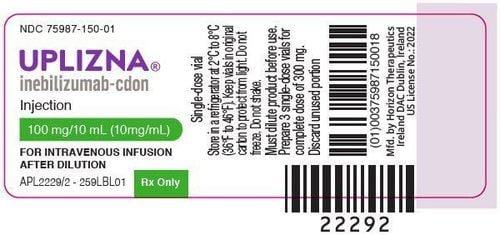This is an automatically translated article.
Articles written by MSc, BS. Nguyen Thi Minh Phuong, Department of General Internal Medicine - Vinmec Times City International General Hospital
Neuromyelitis optica (NMOSD) is a progressive disease with sequelae of sensory, motor, visual acuity, and bladder function that accumulate over time. During an exacerbation, symptoms progress over several days and reach a peak, followed by partial recovery over several weeks or months.
1. What is neuromyelitis optica?
Neuromyelitis Optica Spectrum Disorder (NMOSD) is an autoimmune disease that causes inflammation and demyelinating of the central nervous system, often damaging the optic nerve and spinal cord. . More than a century ago, Davic and Gault described a series of patients with bilateral optic neuritis and myelitis. Hence, neuromyelitis optica is also known as Davic's disease.According to some epidemiological studies, the prevalence of neuromyelitis optica is about 0.5- 10/100000 population. The age of onset is usually from 32-41 years, but in some cases the onset of the disease is earlier or later.
2. Cause
More than 95% of patients with NMOSD have no known familial factors. However, about 50% of patients or their family members have autoimmune diseases. Autoimmune disorders occur when the body's natural defenses against disease or invading organisms (such as bacteria), for unknown reasons, suddenly attack the cells themselves. healthy cells of the body. Likewise, in NMOSD, the body's white blood cells produce antibodies against Aquaporin 4 in the membranes of astrocytes of the central nervous system and optic nerve, leading to a loss of myelin. of nerve cells. In some patients with NMOSD, especially those without relapse, antibodies against MOG (myelin oligodendrocyte glycoprotein) have been found.

Bệnh lý tự miễn có thể là nguyên nhân viêm tủy thị thần kinh
3. Symptoms
The characteristic symptom of neuromyelitis optica is optic neuritis or myelitis.
Optic neuritis is inflammation of the optic nerve, which causes pain in the eye, pain that increases with eye movement, and often progresses rapidly to vision loss or blindness. Symptoms usually begin in one eye, but can occur in both eyes at the same time or progress from one eye to the other. It is difficult to distinguish optic neuritis in neuromyelitis optica from optic neuritis in multiple sclerosis, or idiopathic optic neuritis. Usually optic neuritis is highly suggestive if optic neuritis progresses from one side to the other, or to both sides.
Myelitis is another characteristic syndrome of the disease, also known as transverse myelitis because it often causes motor, sensory, or autonomic symptoms in parts of the body below the level of myelitis lesion. . Patients may have back pain, paralysis of both legs or quadriplegia, accompanied by numbness, loss of sensation or pain in the extremities, urinary retention, and defecation. Symptoms are usually bilateral, but can sometimes occur only on one side of the body. Tendon reflexes are often increased, or initially decreased or lost, and then increased.
Nausea, vomiting or hiccups, which can persist, are sometimes the first symptoms of illness. Daytime narcolepsy, or excessive daytime sleep, autonomic disturbances such as hypotension, bradycardia, decreased body temperature.
4. Diagnosis
Diagnosis is based on history, physical examination and a combination of tests.
Blood test: look for anti-Aquaporin 4 (Aquaporin 4-IgG) or anti-MOG (MOG-IgG) antibodies. Anti-Aquaporin 4 is a very specific and highly sensitive marker for diagnosis. This antibody can appear very early in the patient's blood, as soon as the patient begins to have symptoms. MOG – IgG is seen in about 50% of patients negative for Aquaporin 4-IgG. Cerebrospinal fluid puncture MRI of the cervical spine, MRI of the brain: find images of myelitis and other specific lesions. Measure the visual evoked potential. Optical coherence tomography: Optical coherence tomography.

Chụp MRI cột sống cổ-ngực giúp bác sĩ chẩn đoán viêm tủy thị thần kinh
5. Differential diagnosis
NMOSD needs to be differentiated from multiple sclerosis, an autoimmune disease of the central nervous system whose symptoms are very similar to NMOSD. Diffuse acute encephalomyelitis and other autoimmune diseases such as systemic lupus erythematosus sometimes mimic NMOSD clinically.
Longitudinally extensive spinal cord lesions on MRI are not specific for NMOSD. This lesion can be seen in some other autoimmune or inflammatory diseases such as systemic lupus erythematosus, Sjogren's syndrome, Behcet's disease, sarcoidosis etc. In addition, the cause of prolonged marrow damage can also be due to marrow vascular abnormalities, myeloma, vitamin B12 deficiency, after radiation therapy etc..
6. Treatment
High-dose corticosteroids in exacerbations. If not responding to corticosteroids, combine plasmapheresis.
Immunosuppressive drugs for relapse prevention such as: Azathioprine, Cell Cept, Rituximab, Eculizumab ...
7. Prognosis
NMOSD is a progressive disease with sequelae of sensory, motor, visual acuity, bladder function accumulated over time. During an exacerbation, symptoms progress over several days and reach a peak, followed by partial recovery over several weeks or months.
For the treatment to be effective, early detection time is very important. Therefore, as soon as you have strange symptoms, you should immediately go to a medical facility for examination. Vinmec International General Hospital is a high-quality medical facility in Vietnam with a team of highly qualified medical professionals, well-trained, domestic and foreign, and experienced.
A system of modern and advanced medical equipment, possessing many of the best machines in the world, helping to detect many difficult and dangerous diseases in a short time, supporting the diagnosis and treatment of doctors the most effective. The hospital space is designed according to 5-star hotel standards, giving patients comfort, friendliness and peace of mind.
Please dial HOTLINE for more information or register for an appointment HERE. Download MyVinmec app to make appointments faster and to manage your bookings easily.













